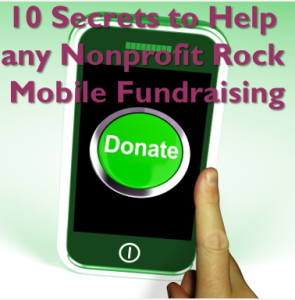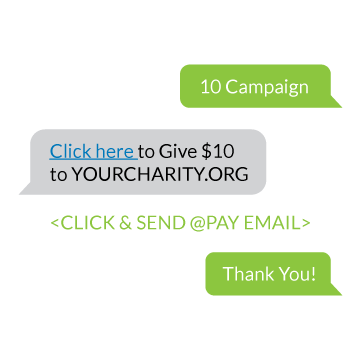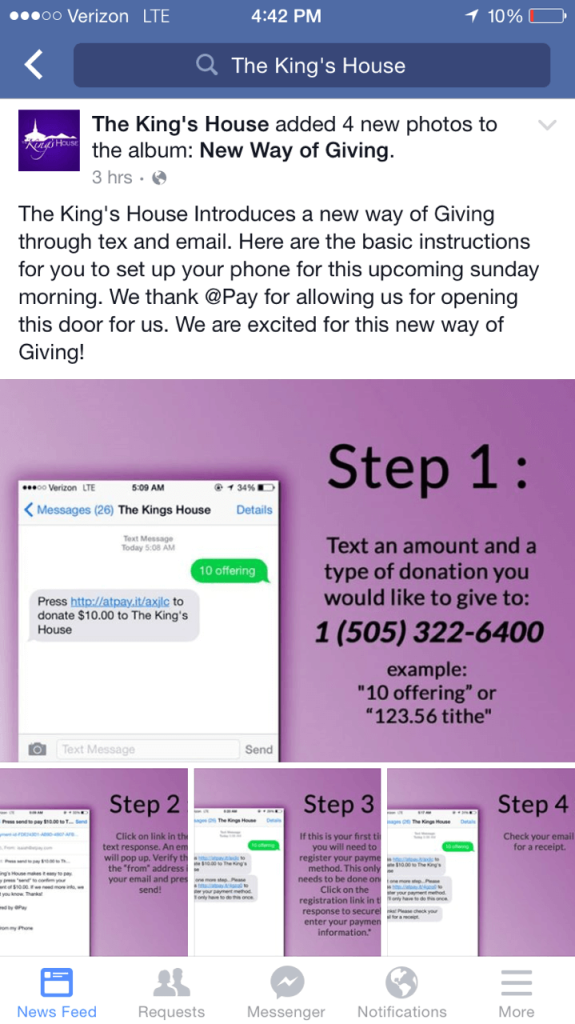 “Human beings have always been social animals. The digital revolution has simply made electronic media (email, the internet and social media) our ‘go-to’ place to socialize and connect with our fellow humans.”
“Human beings have always been social animals. The digital revolution has simply made electronic media (email, the internet and social media) our ‘go-to’ place to socialize and connect with our fellow humans.”
This sentiment that Claire crafted really spoke to me as I was reading her article the other day.
It’s a deep truth. We are social beings. We’re also incredibly mobile now, though.
Ironically, even though we’re constantly on the go, we are the most connected we’ve ever been.
We have technology to thank for that. Technology not only helps us connect with those we love and care about, it also allows us to broaden our reach as nonprofit professionals.
Through avenues like mobile fundraising, we have the ability to raise money to impact the world in a positive way from anywhere. At. Any. Time.
If that doesn’t amaze you, I’m not sure what will!
All of this is just to say that mobile fundraising truly is the way of the future for nonprofits.
We’ve gathered the top ten secrets to help you succeed in launching your very own mobile fundraiser.
Whether you’re launching a text-to-give campaign, an email fundraiser, or a peer-to-peer effort, we’ve got you covered!
#1. Prepare for Mobile
First and foremost, your organization must prepare for a mobile fundraising campaign by becoming more mobile-responsive across the board.
What does it mean to be mobile-responsive?
That’s a great question–and one that has a multifaceted answer.
To put it simply, though, mobile-responsiveness is providing users (your donors and potential donors) with the optimal mobile experience.
The optimal mobile experience entails apps, websites, and emails functioning just as well (if not better) on a mobile device as they would on a desktop or laptop computer.
What does this looks like practically?
- Cleaning up your website to remove excessive text or cluttery pictures.
- Making buttons and text larger, easier to read and easier to press and click on.
- Ensuring that your website and email load in the correct 3” by 5” screen format.
- Making sure that your online fundraising efforts (website, email, donation page) load quickly and respond in a timely manner.
- Reducing the number of required fields for your online donation page.
Of course, how you achieve these various tasks will differ depending on where you are now.
If your nonprofit already has a stellar donation page, perhaps you could work on your email strategy. There are several ways to make your mobile emails more engaging, including:
- Coming up with an eye-catching subject line. (What would make you want to click on an email?)
- Using action words, like “change,” “unite,” “care,” and more! Donors respond well to positive progress; they like to feel like actual change is being effected.
- Adding an email button. Buttons that allow your donors to give within an email will instantaneously increase the chances of an immediate donation .
Granted, if you’re already doing all of this with your email, and you’re rocking your mobile donation page, you’re on the right track.
But before your next mobile fundraising initiative, you’ll want to check all of these updates off of your list.
Every step will bring you closer to engaging with more on-the-go donors than ever before.
Once you’ve made all of the necessary updates to your website, donation pages and email strategy, you’re well on your way to mobile fundraising success.
#2. Incorporate Mobile into Your Existing Plans
You already know how to ask for donations in person, over the phone, and through direct mail.
Now it’s time to figure out how you’ll make mobile fundraising just as much a part of your daily, weekly, and quarterly routines as those other methods of fundraising.
The first step is to figure out all the right questions to ask.
Luckily for you, we’ve come up with the most common who, what, when, and why’s you need to consider before getting started with mobile fundraising.
Who:
As you’re planning your mobile fundraising campaign, you may want to think about who will be in charge of running your efforts.
Will you assign a team to the task? Or will you place one person at the helm? Either way, it’s imperative that you decide who’s in charge before you get the ball rolling.
What:
One of the chief questions you need to answer when you’re getting started is, “What are we hoping to accomplish through mobile fundraising?”
Setting clear goals for your organization at the outset will help you in the long run. Mobile fundraising, while it’s an incredible tool, won’t do the work for you.
If you’re looking for an easy-to-use, easy-to-promote fundraiser, you’re in the right place. That being said, you still need to have clearly defined expectations for how mobile fundraising will fit into your existing plans.
When:
The answer to this question is actually quite simple.
When are you planning to get started? Be strategic about your roll-out date. You may want to coincide your mobile fundraising campaign with another major fundraising event you’re planning. More on this point later on in the article, when live events are discussed.
Where:
When it comes to fundraising of any kind, there are certain legal issues that come up. One of the most important questions that comes up with mobile fundraising is: “Where are we legally allowed to fundraise?”
Because mobile donors can give to your organization from anywhere in the country, you need to be sure that your organization is covered to fundraise all over the U.S.
How:
Once you’ve successfully launched your mobile fundraising campaign, you’ll no doubt be inundated with all sorts of new donor information. Before that happens, you’ll need to prepare a strategy for sorting through all of it.
How will you deal with new, incoming donor information?
Will you incorporate it all into your existing systems, or will you create a new, separate system specifically for mobile donor information?
Why:
The final question: Why not get started? You’re just about ready to go!
#3. Explore Different Avenues
There are several types of mobile fundraising that your nonprofit can experiment with.
The secret to a truly successful mobile fundraiser is to try new tactics until you find the one that best fits your organization’s needs.
Within mobile fundraising, there are:
- Text-to-give campaigns.
- Mobile email fundraisers.
- QR code promotions.
- Social media fundraising campaigns.
- Interactive fundraising thermometers.
- Mobile and online donation pages.
- And more!
While you might not score a major gift through a QR code promotion, you could easily procure a recurring donor through that giving avenue.
The point is: there are so many types of mobile fundraising technology and even more ways to use them effectively.
You don’t have to limit your organization to just one!
That being said, don’t spread yourself too thin. The secret is to strike a nice balance.
To be successful in your endeavors, you must do your research first and figure out the avenues that would best suit your specific donor pool.
If you happen to look up QR codes and find that they’d serve your nonprofit well, you might also want to look into interactive fundraising thermometers (and while you’re at it: text-to-give!). These three work especially well together.
The same goes for mobile email fundraising and mobile donation pages. The two go hand-in-hand.
In the end, your organization will likely find a combination that’s as classic as bacon and eggs (or milk and cookies, if you have a sweet tooth).
#4. Expand Your Network
In all likelihood, your organization has some amazing advocates.
Interested in a way to put advocacy to tangible use and expand your fundraising and volunteer networks at the same time?
One of the top ways to engage your organization’s advocates in a way that truly benefits your nonprofit is peer-to-peer fundraising.
How can you use peer-to-peer to leverage your existing donor base to help your mobile fundraiser succeed?
It’s actually a lot easier than it sounds.
It starts with your organization recruiting your most passionate members:
- Board members
- Avid volunteers
- Vocal advocates
- Committed donors
Once you have their attention, give them the necessary tools they’ll require to fundraise on your behalf.
This could involve:
- Giving them the ability to create their own mobile crowdfunding pages to benefit your cause.
- Showing them how your text-to-give campaign works.
- Sending them an email with a link to your mobile-responsive donation page.
Of course, what tools you introduce them to will depend on what fundraiser you’re attempting to launch.
Now that they’ve got those tools in their tool belts, they’ll be able to go out and spread the word about your awesome mobile fundraiser to their:
- Friends.
- Family.
- Coworkers.
- And more!
If those friends, family, and coworkers all donate, then you’ve expanded your network without spending up to three times as much to acquire them. Your existing donors have done the work for you!
Not only are they new donors, they’re also new potential supporters, advocates, and volunteers.
That’s the magic of peer-to-peer.
For more on peer-to-peer fundraising, check out this in-depth article.
#5. Target Key Demographics
Did you know that 64% of all donations across the board are made by women?
Or that the average text-to-give donor is a college-educated, 49-59-year-old woman?
These are just national averages, of course, so they’re not necessarily true of your donors.
But it may surprise you who’s interested in mobile giving at your organization.
You might assume that because they’re glued to their phones that all millennials are interested in text-to-give technology. That’s simply not true.
Many millennials have cited email as their favorite mode of communication with nonprofits.
The point is: you won’t know until you ask.
Instead of jumping to conclusions about mobile fundraising, you can:
- Send out a survey.
- Take a look at past giving habits.
- Test out mobile fundraising on a select few donors.
Once you’ve established your key demographics, you can segment your donor pool–that way you can more effectively target each individual donor.
Your nonprofit can send out:
- Mobile-responsive emails to donors who respond well to email marketing.
- Direct mail appeals to donors who make a habit of mailing in checks.
- Tweet at donors who love to text-to-give on a regular basis.
Having a clear idea of what your donors prefer will help propel your mobile fundraiser to success and beyond!
#6. Tap into the Power of Social Media
In order to get the most out of your mobile fundraising campaign, you have to market it well.
And what better way to market a mobile fundraiser than through mobile apps?
The secret to marketing mobile through social media is in knowing the differences between sites.
Luckily for you, we’ve gathered together some of the top social media best practices:
Facebook.
Facebook is the most widely used social media site, and it’s one of the most downloaded apps across smartphones.
It also reaches almost every demographic.
Therefore, it’s essential that your nonprofit get on board with Facebook.
What are some best practices?
- Images work well on Facebook. If you include an image of some kind in your posts, they’ll be more likely to be liked and shared, and the word about your mobile fundraiser will spread like wildfire.
- Shorter posts also work better. Reserve your longer updates for long-form social media, like your nonprofit’s blog.
- Finding the ideal time to post is important. In general, engagement with Facebook is highest during the week. Wednesday-Friday from 12 PM – 3 PM is the optimal time.
Here’s an example of an effective Facebook post that details how to use text-to-give:
They do a great job of going step-by-step with the process, so that donors really grasp how to give via text.
Instagram.
Instagram is a social media site that skews younger, so if you have a lot of younger donors, it’s important to engage with them on Instagram.
What are some best practices?
- Keep your captions short, but make sure to include information about your latest mobile fundraising plans.
- You can’t post a link within captions, so you’ll have to allude to the link to your donation page in your bio.
- The best time to post on Instagram is during the week around 5 PM and 2 AM. Sunday is the worst day to try to post.
Here’s a good example of an optimized Instagram post:
As you can see, they’ve chosen an impactful image and they’ve mentioned the link to their donation page that’s in their bio.
Twitter.
Twitter limits posts (called “tweets”) to 140 characters. This makes Twitter the most conducive to quick updates and short posts about your mobile fundraiser.
What are some best practices?
- Keep it short and sweet. Only tweet the most crucial pieces of information.
- Hashtagging your content will make it more easily found and therefore more shareable.
- The best times to tweet are early in the morning and late at night.
Here’s a prime example of a nonprofit’s Twitter that features their mobile fundraiser:
This nonprofit has chosen to provide a link to their mobile donation page in their short tweet.
Snapchat.
Snapchat is a relatively newer form of social media, but it’s one that’s becoming rapidly more popular among younger donors.
It’s a platform that allows users to send and receive pictures and videos that disappear shortly after they’ve been seen. It lends itself really well to instant updates on your nonprofit’s latest projects.
What are some best practices?
- Post videos over pictures, as videos are more compelling for donors.
- Include information about your mobile fundraiser, but refer your viewers to your website so that they can read all about it on their own time.
- Your Snapchat “stories” will get the most views after 10 PM, but you can post anytime (whenever you have consequential updates).
Here’s an example of a Snapchat post that’s simple and straightforward:
 They’ve kept it nice and simple while relaying an important message.
They’ve kept it nice and simple while relaying an important message.
With all of that in mind, you’re ready to tackle social media marketing for your mobile fundraising campaign and more!
#7. Don’t Leave Traditional Methods in the Dust
Even though social media and mobile fundraising do go hand-in-hand, it doesn’t mean that traditional methods should fall by the wayside.
It may seem a little counterintuitive, but some of the best supplements to your mobile fundraiser are actually direct mail letters.
They’re personal, meaningful, and they’re something that people will often save and post up on their fridges.
At the end of your typical fundraising letters, be sure to mention all of the new ways that your donors can give to your organization easily through their mobile phones.
In addition to sending out letters about your mobile fundraising campaign, you can also:
- Send out personalized emails (that are mobile-optimized, of course).
- Post flyers and posters up strategically around town.
- Take out ads in local newspapers and magazines.
- Create promotional materials like shirts and mugs.
- Rent out billboard space or bus stop signs.
- Make phone calls to your donor base.
- And more!
Just because your fundraiser is mobile, your efforts don’t have to be confined to smartphones and tablets.
The more marketing avenues you explore, the more donors you’ll be able to reach on the go.
#8. Pair Mobile Fundraising with Events
One of the best ways to reach a large number of donors at once is through live events.
At a live event, you have several factors working in your favor.
These factors include, but aren’t limited to:
- A captive audience who most likely brought their phones.
- A stage from which to explain your mobile fundraiser.
- An opportunity to pass out tangible information.
What fundraising events work well with mobile fundraising?
- 5K fun runs, marathons, bike-a-thons, and more!
- Live music concerts.
- Virtual bake sales.
- Fundraiser galas.
- And more!
For over 100 unique fundraising ideas that pair well with mobile fundraising, check out @Pay’s fundraising ideas.
The best part is that you’re not only reaching the people who actually attend your event, you also have the possibility of acquiring your attendees’ friends, families, and more.
After they’ve donated to your cause at your event, they’ll be much more likely to tell their social networks about your cause and the awesome new ways that they can give to your organization.
In any case, mobile fundraising and live events are a match made in fundraising heaven.
#9. Know the Importance of Visuals
As you probably already know, visuals are incredibly important when you’re fundraising. They’re especially important when you’re launching a mobile fundraiser, though.
Pictures alone won’t do much to boost your mobile fundraising efforts, though.
Your images need to have meaning behind them. Help your donors decipher your visual messages by providing context and actionable steps alongside your pictures.
Donors need to know why your image is important.
To make the most out of visuals with regard to your mobile fundraiser:
- Choose images that are representative of your cause.
- Make sure that the pictures you choose are well composed and sharply focused.
- Compress the size of your images so that they load well on mobile.
- Provide a caption for all of your images so that their intentions are clear.
At the very least, you should be including visuals:
- In your nonprofit’s mobile emails.
- On your mobile website.
- In your social media posts.
- On your mobile donation page.
If you incorporate beautiful, meaningful images into your mobile fundraising, you’re setting your nonprofit up for major success.
#10. Make Mobile Acknowledgements
“Thank you.”
“Merci.”
“Gracias.”
“Danke.”
There are over a million ways to say thank you. So why would you stop with just one?
One of the most important secrets to rocking a mobile fundraising campaign is knowing how and when to send out acknowledgements.
Because most mobile fundraising software has the option to allow for automatic thank you’s to be sent out, many nonprofits leave it at that.
But the way to retain donors (which we all know is crucial) is to thank them more than once–and in more than one way.
Did a donor text to give to your organization? Shoot them that quick text reply, saying “Thank you!” But follow that up with a sincere, personalized email that details how their donation is being put to good use.
Shoot them that quick text reply, saying “Thank you!” But follow that up with a sincere, personalized email that details how their donation is being put to good use.
It may take up a little more of your time, but in the end, it’s 100% worth it.
That’s the final secret to rocking a mobile fundraising campaign! It really is that simple.
Now that you know the top ten secrets (from an industry insider’s perspective), you’re more than aptly prepared to get out there and get fundraising!
 This is a guest post from Wauker Matthews, Director of Sales at @Pay, an exciting new fundraising technology that makes it easy for people to give in just a few clicks from text, email, web and social media. Wauker has been in brand & business development for over 8 years, helping organizations grow in both size and reach. Was this useful? Let us know in the comments below!
This is a guest post from Wauker Matthews, Director of Sales at @Pay, an exciting new fundraising technology that makes it easy for people to give in just a few clicks from text, email, web and social media. Wauker has been in brand & business development for over 8 years, helping organizations grow in both size and reach. Was this useful? Let us know in the comments below!






